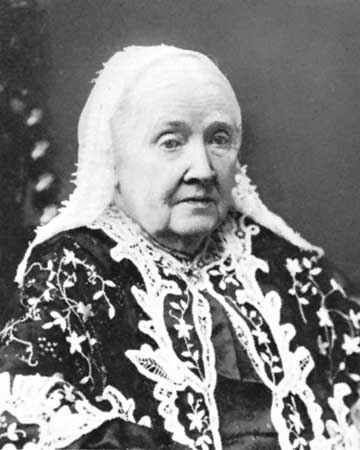Julia Howe (Julia Ward Howe)

Julia Howe was born in New York City. She was the fourth of seven children born to an upper middle class couple. Her father, Samuel Ward III, was a Wall Street stockbroker, well-to-do banker, and strict Calvinist. Her mother, the occasional poet Julia Rush Cutler, was related to Francis Marion, the “Swamp Fox” of the American Revolution. She died of tuberculosis when her daughter was five years old. She was educated by private tutors and in schools for young ladies until she was sixteen. Her eldest brother, Samuel Cutler Ward, travelled in Europe and brought home a private library. She had access to these modern works, many contradicting the Calvinistic world view presented by her father. She became very well read and frighteningly intelligent. Julia, though limited by her father, was as much a social butterfly as she was a scholar; and, because of her father’s status as a successful banker, she was brought into contact with some of the greatest minds of her time. She interacted with Charles Dickens, Charles Sumner, and Margaret Fuller. Sam married into the prominent Astor family, allowing him great social freedom that he shared with his sister. The siblings were cast into mourning time and again: their father died in 1839; shortly afterwards, Howe’s dear brother Henry and brother Samuel’s wife Emily died, along with Emily’s newborn child.
Julia Howe was inspired to write “The Battle Hymn of the Republic” after she and her husband visited Washington, D.C., and met Abraham Lincoln at the White House in November 1861. During the trip, her friend James Freeman Clarke suggested she write new words to the song “John Brown’s Body”, which she did on November 19. The song was set to William Steffe’s already-existing music and Howe’s version was first published in the Atlantic Monthly in February 1862. It quickly became one of the most popular songs of the Union during the American Civil War. Now that Howe was in the public eye, she produced eleven issues of the literary magazine, Northern Lights, in 1867. That same year she wrote about her travels to Europe in From the Oak to the Olive. After the war she focused her activities on the causes of pacifism and women’s suffrage. By 1868, Julia’s husband no longer opposed her involvement in public life, so Julia decided to become active in reform. She helped found the New England Women’s Club and the New England Woman Suffrage Association. She served as president for nine years beginning in 1868. In 1869, she became co-leader with Lucy Stone of the American Woman Suffrage Association. Then, in 1870, she became president of the New England Women’s Club. After her husband’s death in 1876, she focused more on her interests in reform. She was the founder and from 1876 to 1897 president of the Association of American Women, which advocated for women’s education. She also served as president of organizations like the Massachusetts Woman Suffrage Association and the New England Suffrage Association.
In 1870 Julia Howe founded the weekly Woman’s Journal, a suffragist magazine which was widely read. She contributed to it for twenty years. That same year, she wrote her “Appeal to womanhood throughout the world”, later known as the Mother’s Day Proclamation. It asked women from the world to join for world peace. (See Category:Pacifist feminism.) In 1872, she asked that “Mother’s Day” be celebrated on the 2nd of June. Her efforts were not successful, and by 1893 she was wondering if the 4th of July could be remade into “Mother’s Day”. In 1874, she edited a coeducational defense titled Sex and Education. She wrote a collection about the places she lived in 1880 called Modern Society. In 1883, Julia Howe published a biography of Margaret Fuller. Then, in 1885 she published another collection of lectures called Is Polite Society Polite? (“Polite society” is a euphemism for the upper class.) Finally in 1899 she published her popular memoirs, Reminiscences. Julia Howe continued to write until her death. In 1881, Howe was elected president of the Association for the Advancement of Women. Around the same time, Howe went on a speaking tour of the Pacific coast, and founded the Century Club of San Francisco. In 1890, she helped found the General Federation of Women’s Clubs, to reaffirm the Christian values of frugality and moderation. From 1891-1893, she served as president for the second time of the Massachusetts Woman Suffrage Association. Until her death, she was president of the New England Woman Suffrage Association. From 1893 to 1898 she directed the General Federation of Women’s Clubs, and headed the Massachusetts Federation of Women’s Clubs. In 1908 Julia was the first woman to be elected to the American Academy of Arts and Letters, a society; its goal is to “foster, assist, and sustain excellence” in American literature, music, and art.
Julia Howe’s accomplishments mostly reside in her contribution to women’s rights. She laid the foundation for women’s rights groups both in her own home and in the public eye. Howe died of pneumonia October 17, 1910, at her home, Oak Glen, in Portsmouth, Rhode Island at the age of 91. She is buried in the Mount Auburn Cemetery in Cambridge, Massachusetts. At her memorial service approximately 4,000 individuals sang “Battle Hymn of the Republic” as a sign of respect as it was the custom to sing that song at each of Julia’s speaking engagements. After her death, her children collaborated on a biography, published in 1916. It won the Pulitzer Prize for Biography.
Born
- May, 27, 1819
- USA
- New York, New York
Died
- October, 17, 1910
- USA
- Portsmouth, Rhode Island
Cause of Death
- pneumonia
Cemetery
- Mount Auburn Cemetery
- Cambridge, Massachusetts
- USA



